The Dark Side of Fashion: Human Rights Issues in Textiles Industry
VerifiedAdded on 2022/08/27
|22
|4844
|19
Report
AI Summary
This report provides a comprehensive analysis of human rights issues within the global fashion and textile industries. It delves into the systemic inequalities and governance failures that contribute to worker exploitation, particularly impacting women and vulnerable populations. The report highlights critical concerns such as forced labor, discrimination, poor working conditions, and the negative impacts of fast fashion. It examines the role of supply chains, labor regulations, and the challenges faced by workers in both formal and informal sectors. Furthermore, the report discusses the role of countries, companies and organizations in perpetuating and addressing these issues, analyzing the root causes of these problems, including the prioritization of profit over human rights. Finally, it explores potential solutions, including governmental regulations, corporate social responsibility, and the implementation of the UN Guiding Principles on Business and Human Rights, advocating for greater transparency, accountability, and ethical practices within the industry to promote sustainable and equitable development.
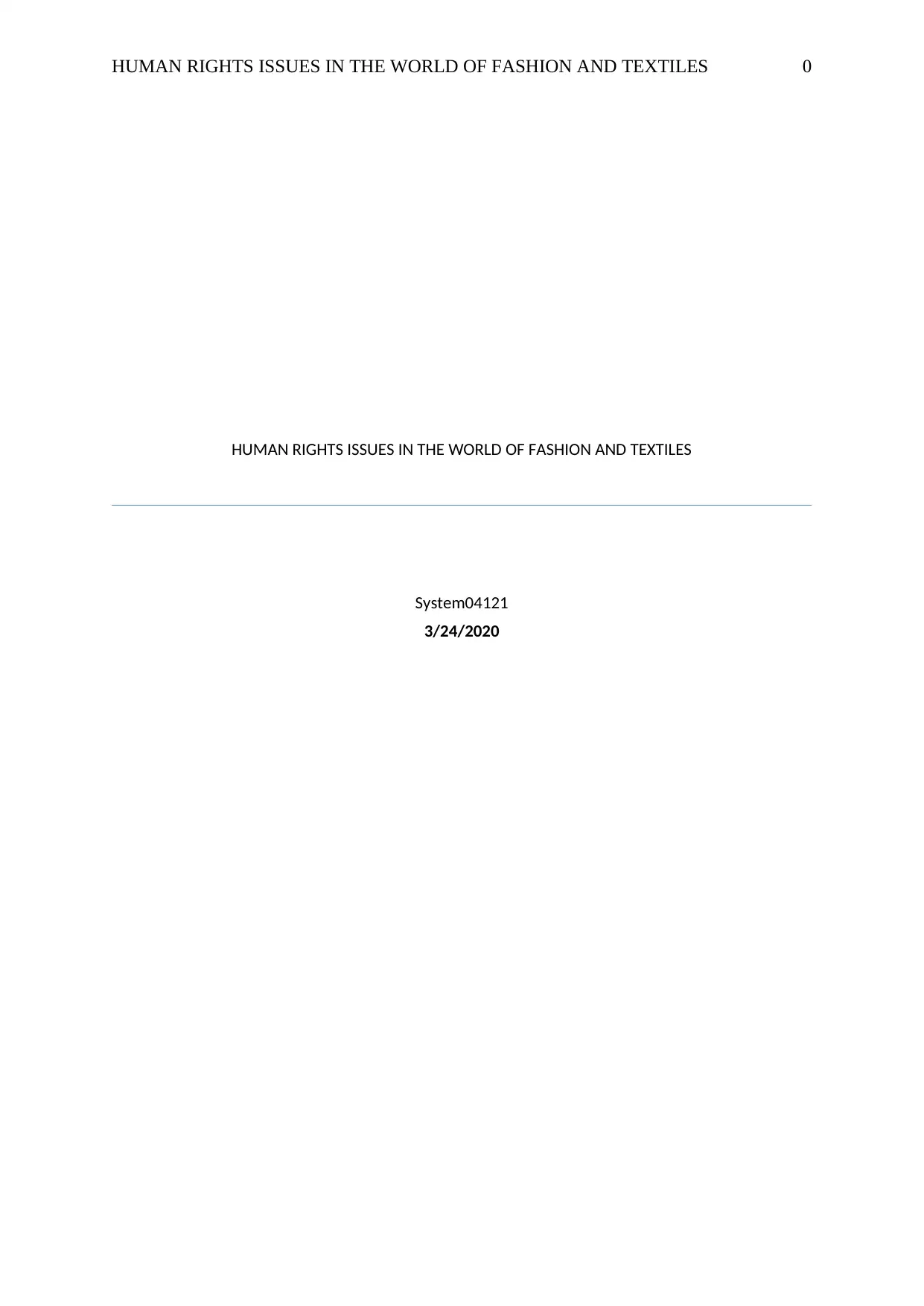
HUMAN RIGHTS ISSUES IN THE WORLD OF FASHION AND TEXTILES 0
HUMAN RIGHTS ISSUES IN THE WORLD OF FASHION AND TEXTILES
System04121
3/24/2020
HUMAN RIGHTS ISSUES IN THE WORLD OF FASHION AND TEXTILES
System04121
3/24/2020
Paraphrase This Document
Need a fresh take? Get an instant paraphrase of this document with our AI Paraphraser
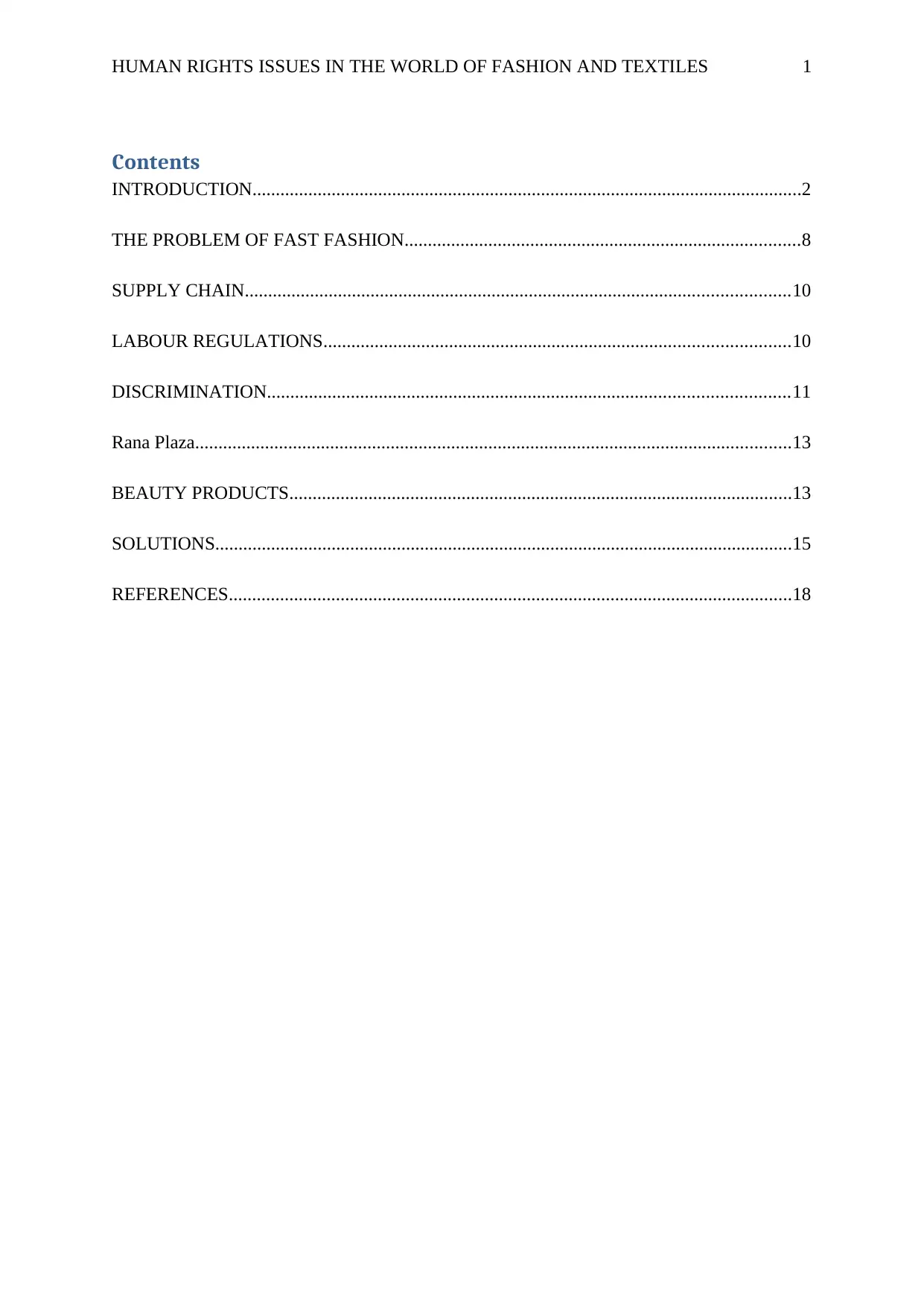
HUMAN RIGHTS ISSUES IN THE WORLD OF FASHION AND TEXTILES 1
Contents
INTRODUCTION......................................................................................................................2
THE PROBLEM OF FAST FASHION.....................................................................................8
SUPPLY CHAIN.....................................................................................................................10
LABOUR REGULATIONS....................................................................................................10
DISCRIMINATION................................................................................................................11
Rana Plaza................................................................................................................................13
BEAUTY PRODUCTS............................................................................................................13
SOLUTIONS............................................................................................................................15
REFERENCES.........................................................................................................................18
Contents
INTRODUCTION......................................................................................................................2
THE PROBLEM OF FAST FASHION.....................................................................................8
SUPPLY CHAIN.....................................................................................................................10
LABOUR REGULATIONS....................................................................................................10
DISCRIMINATION................................................................................................................11
Rana Plaza................................................................................................................................13
BEAUTY PRODUCTS............................................................................................................13
SOLUTIONS............................................................................................................................15
REFERENCES.........................................................................................................................18
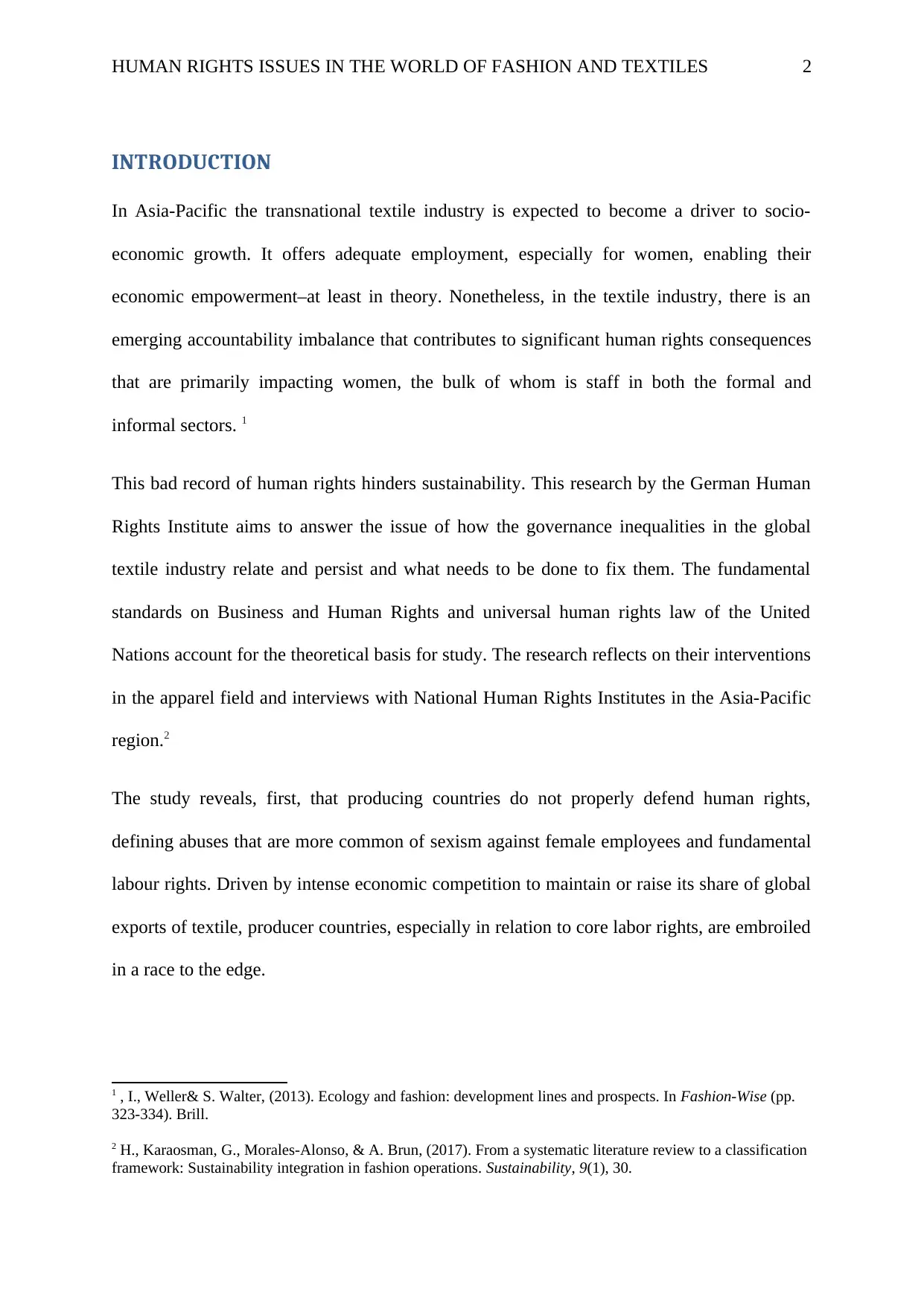
HUMAN RIGHTS ISSUES IN THE WORLD OF FASHION AND TEXTILES 2
INTRODUCTION
In Asia-Pacific the transnational textile industry is expected to become a driver to socio-
economic growth. It offers adequate employment, especially for women, enabling their
economic empowerment–at least in theory. Nonetheless, in the textile industry, there is an
emerging accountability imbalance that contributes to significant human rights consequences
that are primarily impacting women, the bulk of whom is staff in both the formal and
informal sectors. 1
This bad record of human rights hinders sustainability. This research by the German Human
Rights Institute aims to answer the issue of how the governance inequalities in the global
textile industry relate and persist and what needs to be done to fix them. The fundamental
standards on Business and Human Rights and universal human rights law of the United
Nations account for the theoretical basis for study. The research reflects on their interventions
in the apparel field and interviews with National Human Rights Institutes in the Asia-Pacific
region.2
The study reveals, first, that producing countries do not properly defend human rights,
defining abuses that are more common of sexism against female employees and fundamental
labour rights. Driven by intense economic competition to maintain or raise its share of global
exports of textile, producer countries, especially in relation to core labor rights, are embroiled
in a race to the edge.
1 , I., Weller& S. Walter, (2013). Ecology and fashion: development lines and prospects. In Fashion-Wise (pp.
323-334). Brill.
2 H., Karaosman, G., Morales-Alonso, & A. Brun, (2017). From a systematic literature review to a classification
framework: Sustainability integration in fashion operations. Sustainability, 9(1), 30.
INTRODUCTION
In Asia-Pacific the transnational textile industry is expected to become a driver to socio-
economic growth. It offers adequate employment, especially for women, enabling their
economic empowerment–at least in theory. Nonetheless, in the textile industry, there is an
emerging accountability imbalance that contributes to significant human rights consequences
that are primarily impacting women, the bulk of whom is staff in both the formal and
informal sectors. 1
This bad record of human rights hinders sustainability. This research by the German Human
Rights Institute aims to answer the issue of how the governance inequalities in the global
textile industry relate and persist and what needs to be done to fix them. The fundamental
standards on Business and Human Rights and universal human rights law of the United
Nations account for the theoretical basis for study. The research reflects on their interventions
in the apparel field and interviews with National Human Rights Institutes in the Asia-Pacific
region.2
The study reveals, first, that producing countries do not properly defend human rights,
defining abuses that are more common of sexism against female employees and fundamental
labour rights. Driven by intense economic competition to maintain or raise its share of global
exports of textile, producer countries, especially in relation to core labor rights, are embroiled
in a race to the edge.
1 , I., Weller& S. Walter, (2013). Ecology and fashion: development lines and prospects. In Fashion-Wise (pp.
323-334). Brill.
2 H., Karaosman, G., Morales-Alonso, & A. Brun, (2017). From a systematic literature review to a classification
framework: Sustainability integration in fashion operations. Sustainability, 9(1), 30.
⊘ This is a preview!⊘
Do you want full access?
Subscribe today to unlock all pages.

Trusted by 1+ million students worldwide
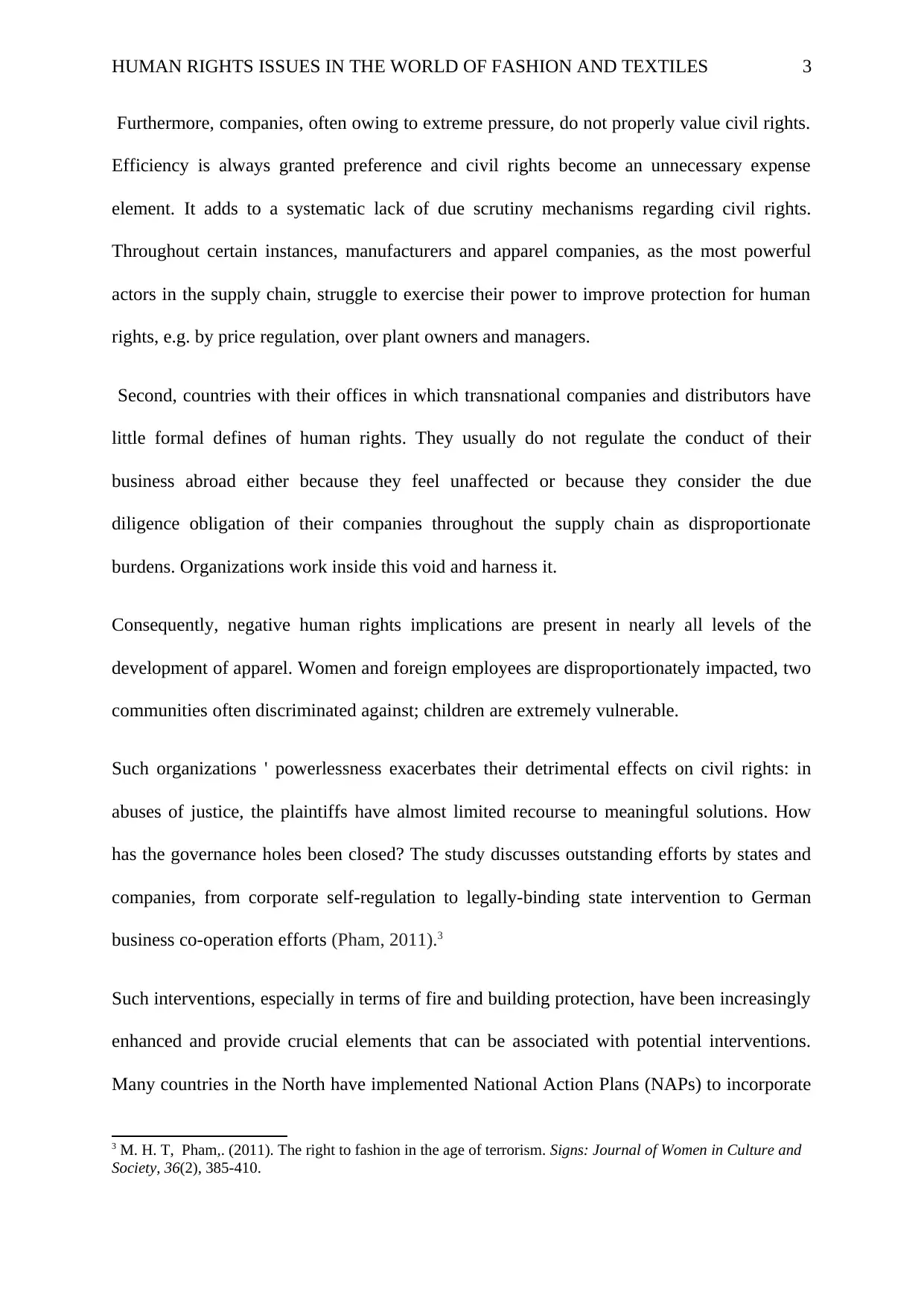
HUMAN RIGHTS ISSUES IN THE WORLD OF FASHION AND TEXTILES 3
Furthermore, companies, often owing to extreme pressure, do not properly value civil rights.
Efficiency is always granted preference and civil rights become an unnecessary expense
element. It adds to a systematic lack of due scrutiny mechanisms regarding civil rights.
Throughout certain instances, manufacturers and apparel companies, as the most powerful
actors in the supply chain, struggle to exercise their power to improve protection for human
rights, e.g. by price regulation, over plant owners and managers.
Second, countries with their offices in which transnational companies and distributors have
little formal defines of human rights. They usually do not regulate the conduct of their
business abroad either because they feel unaffected or because they consider the due
diligence obligation of their companies throughout the supply chain as disproportionate
burdens. Organizations work inside this void and harness it.
Consequently, negative human rights implications are present in nearly all levels of the
development of apparel. Women and foreign employees are disproportionately impacted, two
communities often discriminated against; children are extremely vulnerable.
Such organizations ' powerlessness exacerbates their detrimental effects on civil rights: in
abuses of justice, the plaintiffs have almost limited recourse to meaningful solutions. How
has the governance holes been closed? The study discusses outstanding efforts by states and
companies, from corporate self-regulation to legally-binding state intervention to German
business co-operation efforts (Pham, 2011).3
Such interventions, especially in terms of fire and building protection, have been increasingly
enhanced and provide crucial elements that can be associated with potential interventions.
Many countries in the North have implemented National Action Plans (NAPs) to incorporate
3 M. H. T, Pham,. (2011). The right to fashion in the age of terrorism. Signs: Journal of Women in Culture and
Society, 36(2), 385-410.
Furthermore, companies, often owing to extreme pressure, do not properly value civil rights.
Efficiency is always granted preference and civil rights become an unnecessary expense
element. It adds to a systematic lack of due scrutiny mechanisms regarding civil rights.
Throughout certain instances, manufacturers and apparel companies, as the most powerful
actors in the supply chain, struggle to exercise their power to improve protection for human
rights, e.g. by price regulation, over plant owners and managers.
Second, countries with their offices in which transnational companies and distributors have
little formal defines of human rights. They usually do not regulate the conduct of their
business abroad either because they feel unaffected or because they consider the due
diligence obligation of their companies throughout the supply chain as disproportionate
burdens. Organizations work inside this void and harness it.
Consequently, negative human rights implications are present in nearly all levels of the
development of apparel. Women and foreign employees are disproportionately impacted, two
communities often discriminated against; children are extremely vulnerable.
Such organizations ' powerlessness exacerbates their detrimental effects on civil rights: in
abuses of justice, the plaintiffs have almost limited recourse to meaningful solutions. How
has the governance holes been closed? The study discusses outstanding efforts by states and
companies, from corporate self-regulation to legally-binding state intervention to German
business co-operation efforts (Pham, 2011).3
Such interventions, especially in terms of fire and building protection, have been increasingly
enhanced and provide crucial elements that can be associated with potential interventions.
Many countries in the North have implemented National Action Plans (NAPs) to incorporate
3 M. H. T, Pham,. (2011). The right to fashion in the age of terrorism. Signs: Journal of Women in Culture and
Society, 36(2), 385-410.
Paraphrase This Document
Need a fresh take? Get an instant paraphrase of this document with our AI Paraphraser
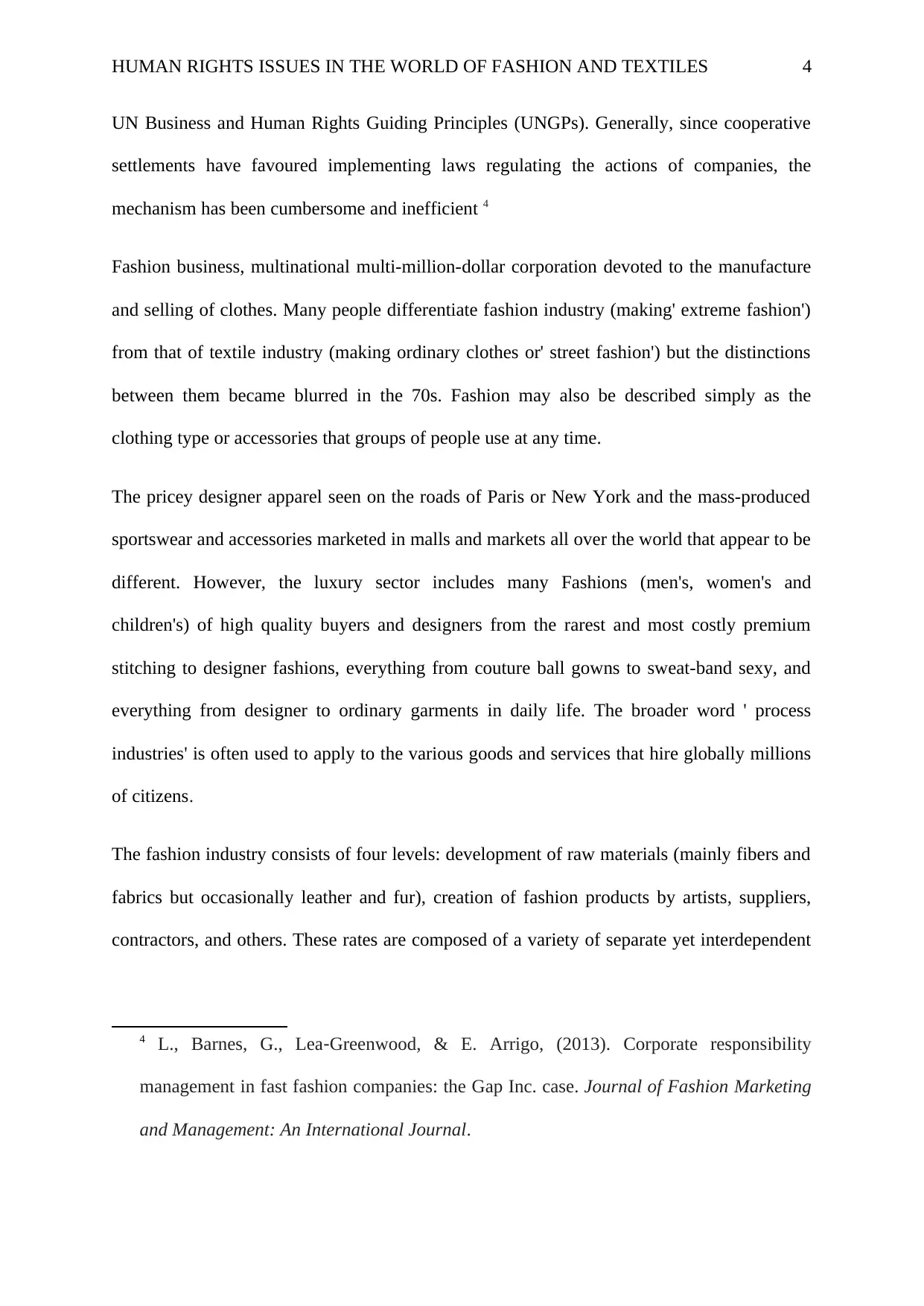
HUMAN RIGHTS ISSUES IN THE WORLD OF FASHION AND TEXTILES 4
UN Business and Human Rights Guiding Principles (UNGPs). Generally, since cooperative
settlements have favoured implementing laws regulating the actions of companies, the
mechanism has been cumbersome and inefficient 4
Fashion business, multinational multi-million-dollar corporation devoted to the manufacture
and selling of clothes. Many people differentiate fashion industry (making' extreme fashion')
from that of textile industry (making ordinary clothes or' street fashion') but the distinctions
between them became blurred in the 70s. Fashion may also be described simply as the
clothing type or accessories that groups of people use at any time.
The pricey designer apparel seen on the roads of Paris or New York and the mass-produced
sportswear and accessories marketed in malls and markets all over the world that appear to be
different. However, the luxury sector includes many Fashions (men's, women's and
children's) of high quality buyers and designers from the rarest and most costly premium
stitching to designer fashions, everything from couture ball gowns to sweat-band sexy, and
everything from designer to ordinary garments in daily life. The broader word ' process
industries' is often used to apply to the various goods and services that hire globally millions
of citizens.
The fashion industry consists of four levels: development of raw materials (mainly fibers and
fabrics but occasionally leather and fur), creation of fashion products by artists, suppliers,
contractors, and others. These rates are composed of a variety of separate yet interdependent
4 L., Barnes, G., Lea‐Greenwood, & E. Arrigo, (2013). Corporate responsibility
management in fast fashion companies: the Gap Inc. case. Journal of Fashion Marketing
and Management: An International Journal.
UN Business and Human Rights Guiding Principles (UNGPs). Generally, since cooperative
settlements have favoured implementing laws regulating the actions of companies, the
mechanism has been cumbersome and inefficient 4
Fashion business, multinational multi-million-dollar corporation devoted to the manufacture
and selling of clothes. Many people differentiate fashion industry (making' extreme fashion')
from that of textile industry (making ordinary clothes or' street fashion') but the distinctions
between them became blurred in the 70s. Fashion may also be described simply as the
clothing type or accessories that groups of people use at any time.
The pricey designer apparel seen on the roads of Paris or New York and the mass-produced
sportswear and accessories marketed in malls and markets all over the world that appear to be
different. However, the luxury sector includes many Fashions (men's, women's and
children's) of high quality buyers and designers from the rarest and most costly premium
stitching to designer fashions, everything from couture ball gowns to sweat-band sexy, and
everything from designer to ordinary garments in daily life. The broader word ' process
industries' is often used to apply to the various goods and services that hire globally millions
of citizens.
The fashion industry consists of four levels: development of raw materials (mainly fibers and
fabrics but occasionally leather and fur), creation of fashion products by artists, suppliers,
contractors, and others. These rates are composed of a variety of separate yet interdependent
4 L., Barnes, G., Lea‐Greenwood, & E. Arrigo, (2013). Corporate responsibility
management in fast fashion companies: the Gap Inc. case. Journal of Fashion Marketing
and Management: An International Journal.
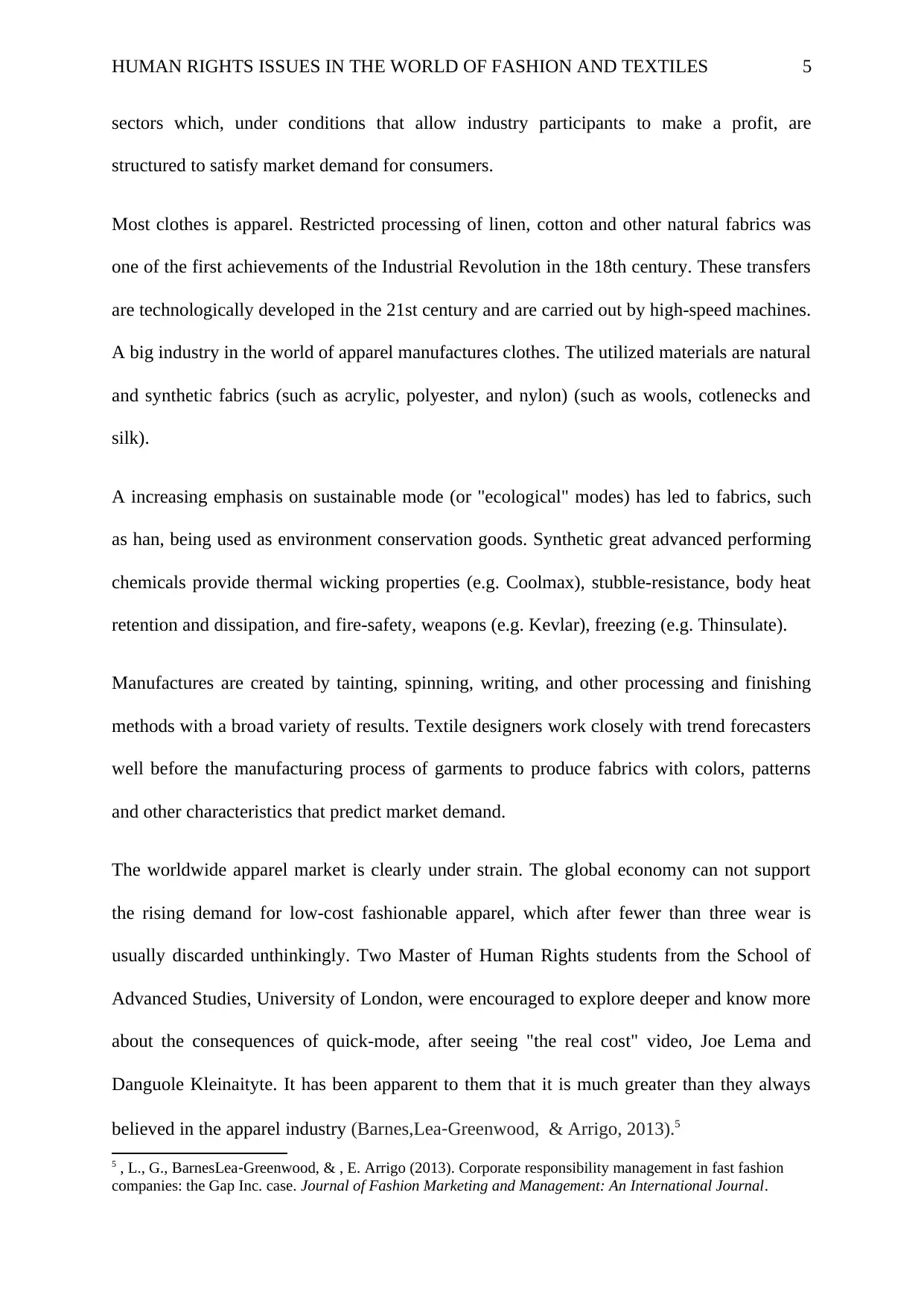
HUMAN RIGHTS ISSUES IN THE WORLD OF FASHION AND TEXTILES 5
sectors which, under conditions that allow industry participants to make a profit, are
structured to satisfy market demand for consumers.
Most clothes is apparel. Restricted processing of linen, cotton and other natural fabrics was
one of the first achievements of the Industrial Revolution in the 18th century. These transfers
are technologically developed in the 21st century and are carried out by high-speed machines.
A big industry in the world of apparel manufactures clothes. The utilized materials are natural
and synthetic fabrics (such as acrylic, polyester, and nylon) (such as wools, cotlenecks and
silk).
A increasing emphasis on sustainable mode (or "ecological" modes) has led to fabrics, such
as han, being used as environment conservation goods. Synthetic great advanced performing
chemicals provide thermal wicking properties (e.g. Coolmax), stubble-resistance, body heat
retention and dissipation, and fire-safety, weapons (e.g. Kevlar), freezing (e.g. Thinsulate).
Manufactures are created by tainting, spinning, writing, and other processing and finishing
methods with a broad variety of results. Textile designers work closely with trend forecasters
well before the manufacturing process of garments to produce fabrics with colors, patterns
and other characteristics that predict market demand.
The worldwide apparel market is clearly under strain. The global economy can not support
the rising demand for low-cost fashionable apparel, which after fewer than three wear is
usually discarded unthinkingly. Two Master of Human Rights students from the School of
Advanced Studies, University of London, were encouraged to explore deeper and know more
about the consequences of quick-mode, after seeing "the real cost" video, Joe Lema and
Danguole Kleinaityte. It has been apparent to them that it is much greater than they always
believed in the apparel industry (Barnes,Lea‐Greenwood, & Arrigo, 2013).5
5 , L., G., BarnesLea‐Greenwood, & , E. Arrigo (2013). Corporate responsibility management in fast fashion
companies: the Gap Inc. case. Journal of Fashion Marketing and Management: An International Journal.
sectors which, under conditions that allow industry participants to make a profit, are
structured to satisfy market demand for consumers.
Most clothes is apparel. Restricted processing of linen, cotton and other natural fabrics was
one of the first achievements of the Industrial Revolution in the 18th century. These transfers
are technologically developed in the 21st century and are carried out by high-speed machines.
A big industry in the world of apparel manufactures clothes. The utilized materials are natural
and synthetic fabrics (such as acrylic, polyester, and nylon) (such as wools, cotlenecks and
silk).
A increasing emphasis on sustainable mode (or "ecological" modes) has led to fabrics, such
as han, being used as environment conservation goods. Synthetic great advanced performing
chemicals provide thermal wicking properties (e.g. Coolmax), stubble-resistance, body heat
retention and dissipation, and fire-safety, weapons (e.g. Kevlar), freezing (e.g. Thinsulate).
Manufactures are created by tainting, spinning, writing, and other processing and finishing
methods with a broad variety of results. Textile designers work closely with trend forecasters
well before the manufacturing process of garments to produce fabrics with colors, patterns
and other characteristics that predict market demand.
The worldwide apparel market is clearly under strain. The global economy can not support
the rising demand for low-cost fashionable apparel, which after fewer than three wear is
usually discarded unthinkingly. Two Master of Human Rights students from the School of
Advanced Studies, University of London, were encouraged to explore deeper and know more
about the consequences of quick-mode, after seeing "the real cost" video, Joe Lema and
Danguole Kleinaityte. It has been apparent to them that it is much greater than they always
believed in the apparel industry (Barnes,Lea‐Greenwood, & Arrigo, 2013).5
5 , L., G., BarnesLea‐Greenwood, & , E. Arrigo (2013). Corporate responsibility management in fast fashion
companies: the Gap Inc. case. Journal of Fashion Marketing and Management: An International Journal.
⊘ This is a preview!⊘
Do you want full access?
Subscribe today to unlock all pages.

Trusted by 1+ million students worldwide
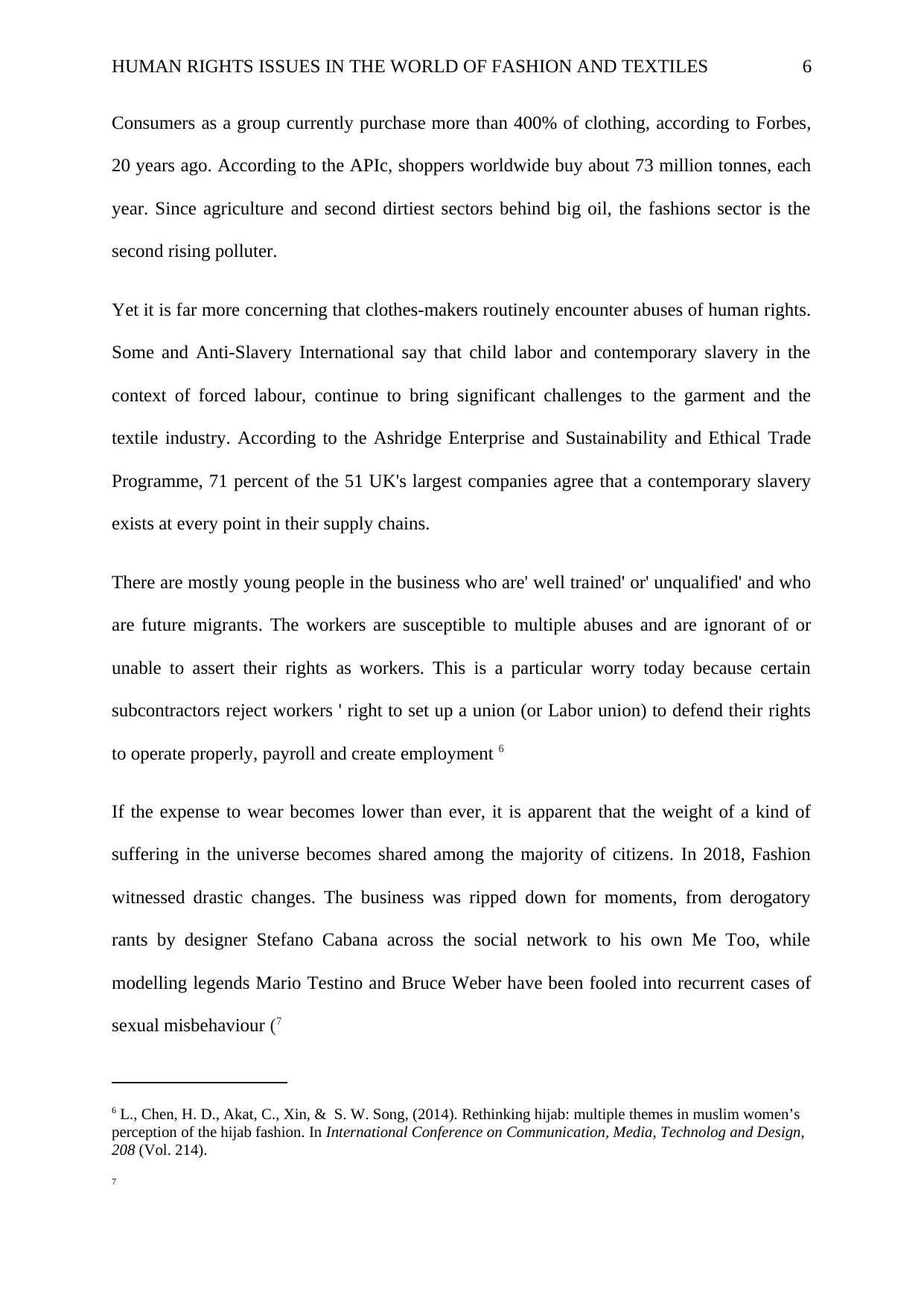
HUMAN RIGHTS ISSUES IN THE WORLD OF FASHION AND TEXTILES 6
Consumers as a group currently purchase more than 400% of clothing, according to Forbes,
20 years ago. According to the APIc, shoppers worldwide buy about 73 million tonnes, each
year. Since agriculture and second dirtiest sectors behind big oil, the fashions sector is the
second rising polluter.
Yet it is far more concerning that clothes-makers routinely encounter abuses of human rights.
Some and Anti-Slavery International say that child labor and contemporary slavery in the
context of forced labour, continue to bring significant challenges to the garment and the
textile industry. According to the Ashridge Enterprise and Sustainability and Ethical Trade
Programme, 71 percent of the 51 UK's largest companies agree that a contemporary slavery
exists at every point in their supply chains.
There are mostly young people in the business who are' well trained' or' unqualified' and who
are future migrants. The workers are susceptible to multiple abuses and are ignorant of or
unable to assert their rights as workers. This is a particular worry today because certain
subcontractors reject workers ' right to set up a union (or Labor union) to defend their rights
to operate properly, payroll and create employment 6
If the expense to wear becomes lower than ever, it is apparent that the weight of a kind of
suffering in the universe becomes shared among the majority of citizens. In 2018, Fashion
witnessed drastic changes. The business was ripped down for moments, from derogatory
rants by designer Stefano Cabana across the social network to his own Me Too, while
modelling legends Mario Testino and Bruce Weber have been fooled into recurrent cases of
sexual misbehaviour (7
6 L., Chen, H. D., Akat, C., Xin, & S. W. Song, (2014). Rethinking hijab: multiple themes in muslim women’s
perception of the hijab fashion. In International Conference on Communication, Media, Technolog and Design,
208 (Vol. 214).
7
Consumers as a group currently purchase more than 400% of clothing, according to Forbes,
20 years ago. According to the APIc, shoppers worldwide buy about 73 million tonnes, each
year. Since agriculture and second dirtiest sectors behind big oil, the fashions sector is the
second rising polluter.
Yet it is far more concerning that clothes-makers routinely encounter abuses of human rights.
Some and Anti-Slavery International say that child labor and contemporary slavery in the
context of forced labour, continue to bring significant challenges to the garment and the
textile industry. According to the Ashridge Enterprise and Sustainability and Ethical Trade
Programme, 71 percent of the 51 UK's largest companies agree that a contemporary slavery
exists at every point in their supply chains.
There are mostly young people in the business who are' well trained' or' unqualified' and who
are future migrants. The workers are susceptible to multiple abuses and are ignorant of or
unable to assert their rights as workers. This is a particular worry today because certain
subcontractors reject workers ' right to set up a union (or Labor union) to defend their rights
to operate properly, payroll and create employment 6
If the expense to wear becomes lower than ever, it is apparent that the weight of a kind of
suffering in the universe becomes shared among the majority of citizens. In 2018, Fashion
witnessed drastic changes. The business was ripped down for moments, from derogatory
rants by designer Stefano Cabana across the social network to his own Me Too, while
modelling legends Mario Testino and Bruce Weber have been fooled into recurrent cases of
sexual misbehaviour (7
6 L., Chen, H. D., Akat, C., Xin, & S. W. Song, (2014). Rethinking hijab: multiple themes in muslim women’s
perception of the hijab fashion. In International Conference on Communication, Media, Technolog and Design,
208 (Vol. 214).
7
Paraphrase This Document
Need a fresh take? Get an instant paraphrase of this document with our AI Paraphraser
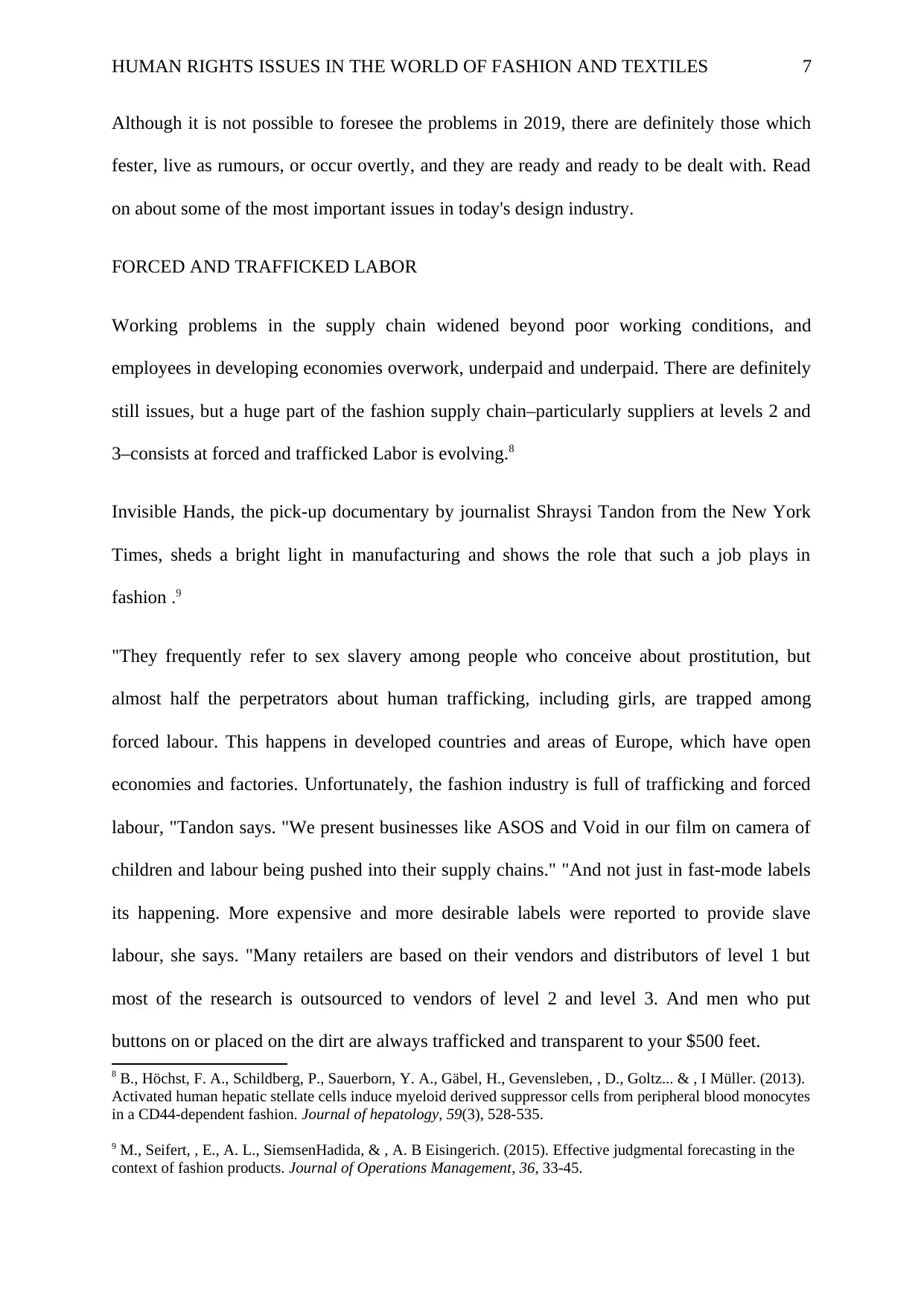
HUMAN RIGHTS ISSUES IN THE WORLD OF FASHION AND TEXTILES 7
Although it is not possible to foresee the problems in 2019, there are definitely those which
fester, live as rumours, or occur overtly, and they are ready and ready to be dealt with. Read
on about some of the most important issues in today's design industry.
FORCED AND TRAFFICKED LABOR
Working problems in the supply chain widened beyond poor working conditions, and
employees in developing economies overwork, underpaid and underpaid. There are definitely
still issues, but a huge part of the fashion supply chain–particularly suppliers at levels 2 and
3–consists at forced and trafficked Labor is evolving.8
Invisible Hands, the pick-up documentary by journalist Shraysi Tandon from the New York
Times, sheds a bright light in manufacturing and shows the role that such a job plays in
fashion .9
"They frequently refer to sex slavery among people who conceive about prostitution, but
almost half the perpetrators about human trafficking, including girls, are trapped among
forced labour. This happens in developed countries and areas of Europe, which have open
economies and factories. Unfortunately, the fashion industry is full of trafficking and forced
labour, "Tandon says. "We present businesses like ASOS and Void in our film on camera of
children and labour being pushed into their supply chains." "And not just in fast-mode labels
its happening. More expensive and more desirable labels were reported to provide slave
labour, she says. "Many retailers are based on their vendors and distributors of level 1 but
most of the research is outsourced to vendors of level 2 and level 3. And men who put
buttons on or placed on the dirt are always trafficked and transparent to your $500 feet.
8 B., Höchst, F. A., Schildberg, P., Sauerborn, Y. A., Gäbel, H., Gevensleben, , D., Goltz... & , I Müller. (2013).
Activated human hepatic stellate cells induce myeloid derived suppressor cells from peripheral blood monocytes
in a CD44-dependent fashion. Journal of hepatology, 59(3), 528-535.
9 M., Seifert, , E., A. L., SiemsenHadida, & , A. B Eisingerich. (2015). Effective judgmental forecasting in the
context of fashion products. Journal of Operations Management, 36, 33-45.
Although it is not possible to foresee the problems in 2019, there are definitely those which
fester, live as rumours, or occur overtly, and they are ready and ready to be dealt with. Read
on about some of the most important issues in today's design industry.
FORCED AND TRAFFICKED LABOR
Working problems in the supply chain widened beyond poor working conditions, and
employees in developing economies overwork, underpaid and underpaid. There are definitely
still issues, but a huge part of the fashion supply chain–particularly suppliers at levels 2 and
3–consists at forced and trafficked Labor is evolving.8
Invisible Hands, the pick-up documentary by journalist Shraysi Tandon from the New York
Times, sheds a bright light in manufacturing and shows the role that such a job plays in
fashion .9
"They frequently refer to sex slavery among people who conceive about prostitution, but
almost half the perpetrators about human trafficking, including girls, are trapped among
forced labour. This happens in developed countries and areas of Europe, which have open
economies and factories. Unfortunately, the fashion industry is full of trafficking and forced
labour, "Tandon says. "We present businesses like ASOS and Void in our film on camera of
children and labour being pushed into their supply chains." "And not just in fast-mode labels
its happening. More expensive and more desirable labels were reported to provide slave
labour, she says. "Many retailers are based on their vendors and distributors of level 1 but
most of the research is outsourced to vendors of level 2 and level 3. And men who put
buttons on or placed on the dirt are always trafficked and transparent to your $500 feet.
8 B., Höchst, F. A., Schildberg, P., Sauerborn, Y. A., Gäbel, H., Gevensleben, , D., Goltz... & , I Müller. (2013).
Activated human hepatic stellate cells induce myeloid derived suppressor cells from peripheral blood monocytes
in a CD44-dependent fashion. Journal of hepatology, 59(3), 528-535.
9 M., Seifert, , E., A. L., SiemsenHadida, & , A. B Eisingerich. (2015). Effective judgmental forecasting in the
context of fashion products. Journal of Operations Management, 36, 33-45.
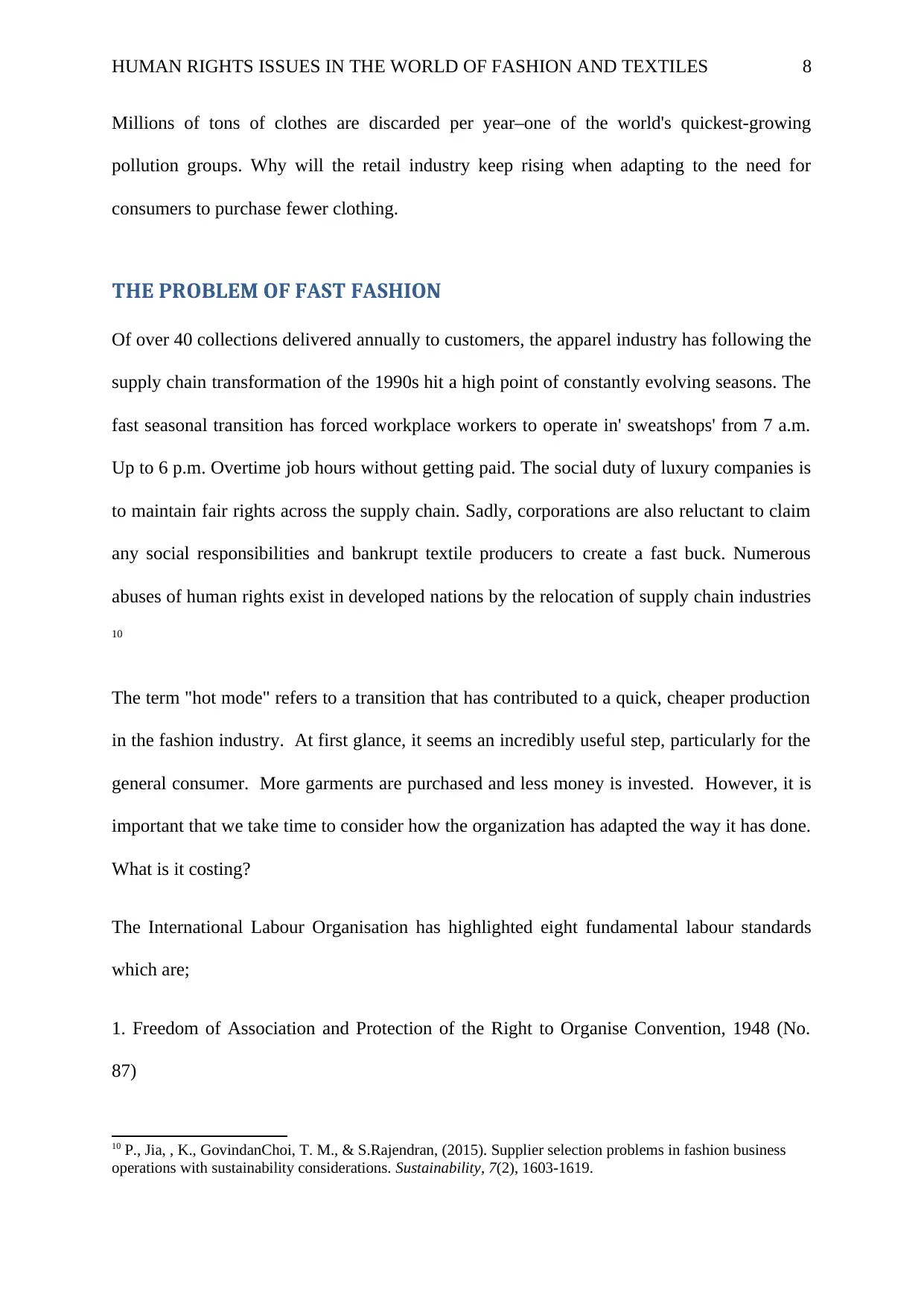
HUMAN RIGHTS ISSUES IN THE WORLD OF FASHION AND TEXTILES 8
Millions of tons of clothes are discarded per year–one of the world's quickest-growing
pollution groups. Why will the retail industry keep rising when adapting to the need for
consumers to purchase fewer clothing.
THE PROBLEM OF FAST FASHION
Of over 40 collections delivered annually to customers, the apparel industry has following the
supply chain transformation of the 1990s hit a high point of constantly evolving seasons. The
fast seasonal transition has forced workplace workers to operate in' sweatshops' from 7 a.m.
Up to 6 p.m. Overtime job hours without getting paid. The social duty of luxury companies is
to maintain fair rights across the supply chain. Sadly, corporations are also reluctant to claim
any social responsibilities and bankrupt textile producers to create a fast buck. Numerous
abuses of human rights exist in developed nations by the relocation of supply chain industries
10
The term "hot mode" refers to a transition that has contributed to a quick, cheaper production
in the fashion industry. At first glance, it seems an incredibly useful step, particularly for the
general consumer. More garments are purchased and less money is invested. However, it is
important that we take time to consider how the organization has adapted the way it has done.
What is it costing?
The International Labour Organisation has highlighted eight fundamental labour standards
which are;
1. Freedom of Association and Protection of the Right to Organise Convention, 1948 (No.
87)
10 P., Jia, , K., GovindanChoi, T. M., & S.Rajendran, (2015). Supplier selection problems in fashion business
operations with sustainability considerations. Sustainability, 7(2), 1603-1619.
Millions of tons of clothes are discarded per year–one of the world's quickest-growing
pollution groups. Why will the retail industry keep rising when adapting to the need for
consumers to purchase fewer clothing.
THE PROBLEM OF FAST FASHION
Of over 40 collections delivered annually to customers, the apparel industry has following the
supply chain transformation of the 1990s hit a high point of constantly evolving seasons. The
fast seasonal transition has forced workplace workers to operate in' sweatshops' from 7 a.m.
Up to 6 p.m. Overtime job hours without getting paid. The social duty of luxury companies is
to maintain fair rights across the supply chain. Sadly, corporations are also reluctant to claim
any social responsibilities and bankrupt textile producers to create a fast buck. Numerous
abuses of human rights exist in developed nations by the relocation of supply chain industries
10
The term "hot mode" refers to a transition that has contributed to a quick, cheaper production
in the fashion industry. At first glance, it seems an incredibly useful step, particularly for the
general consumer. More garments are purchased and less money is invested. However, it is
important that we take time to consider how the organization has adapted the way it has done.
What is it costing?
The International Labour Organisation has highlighted eight fundamental labour standards
which are;
1. Freedom of Association and Protection of the Right to Organise Convention, 1948 (No.
87)
10 P., Jia, , K., GovindanChoi, T. M., & S.Rajendran, (2015). Supplier selection problems in fashion business
operations with sustainability considerations. Sustainability, 7(2), 1603-1619.
⊘ This is a preview!⊘
Do you want full access?
Subscribe today to unlock all pages.

Trusted by 1+ million students worldwide
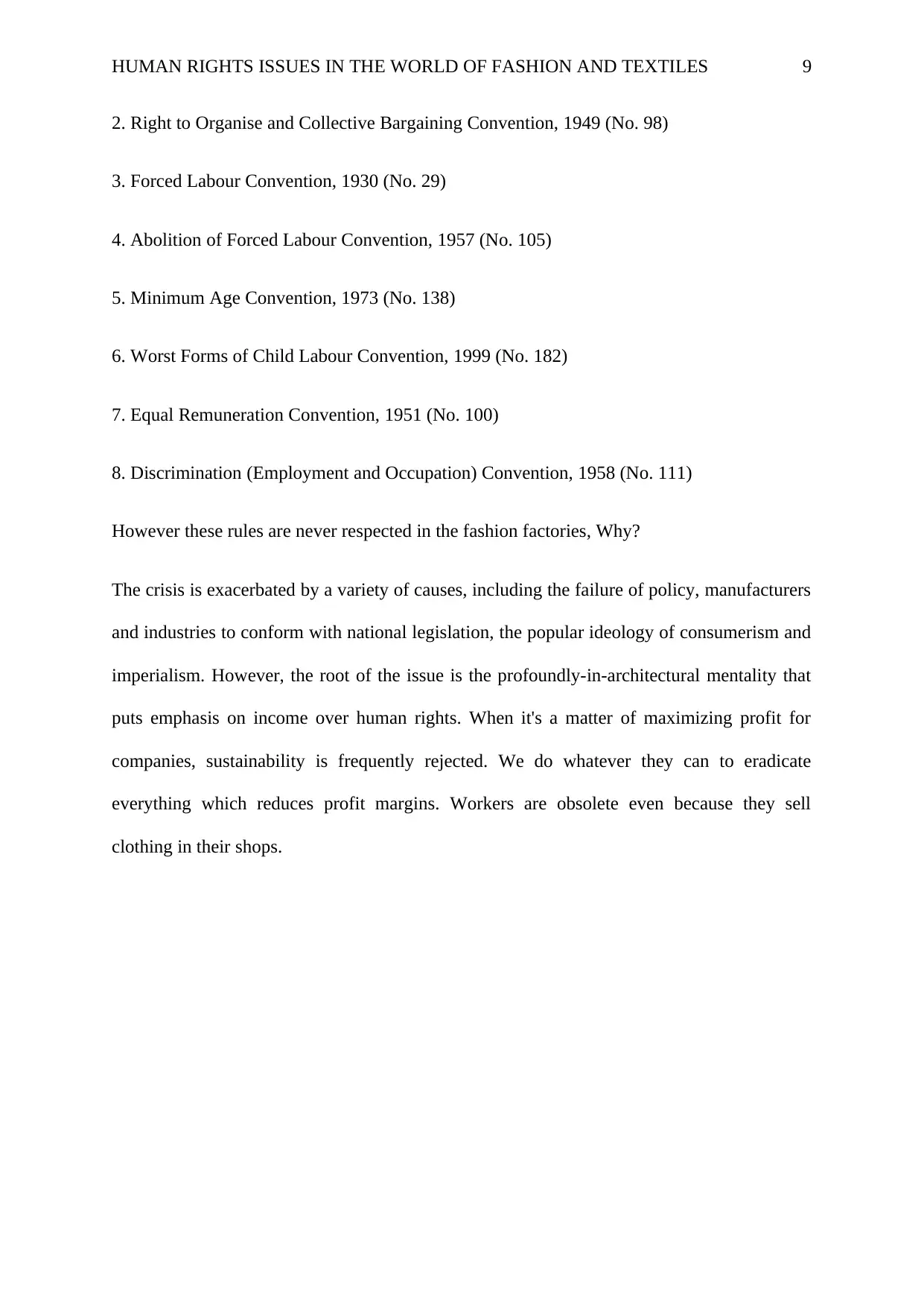
HUMAN RIGHTS ISSUES IN THE WORLD OF FASHION AND TEXTILES 9
2. Right to Organise and Collective Bargaining Convention, 1949 (No. 98)
3. Forced Labour Convention, 1930 (No. 29)
4. Abolition of Forced Labour Convention, 1957 (No. 105)
5. Minimum Age Convention, 1973 (No. 138)
6. Worst Forms of Child Labour Convention, 1999 (No. 182)
7. Equal Remuneration Convention, 1951 (No. 100)
8. Discrimination (Employment and Occupation) Convention, 1958 (No. 111)
However these rules are never respected in the fashion factories, Why?
The crisis is exacerbated by a variety of causes, including the failure of policy, manufacturers
and industries to conform with national legislation, the popular ideology of consumerism and
imperialism. However, the root of the issue is the profoundly-in-architectural mentality that
puts emphasis on income over human rights. When it's a matter of maximizing profit for
companies, sustainability is frequently rejected. We do whatever they can to eradicate
everything which reduces profit margins. Workers are obsolete even because they sell
clothing in their shops.
2. Right to Organise and Collective Bargaining Convention, 1949 (No. 98)
3. Forced Labour Convention, 1930 (No. 29)
4. Abolition of Forced Labour Convention, 1957 (No. 105)
5. Minimum Age Convention, 1973 (No. 138)
6. Worst Forms of Child Labour Convention, 1999 (No. 182)
7. Equal Remuneration Convention, 1951 (No. 100)
8. Discrimination (Employment and Occupation) Convention, 1958 (No. 111)
However these rules are never respected in the fashion factories, Why?
The crisis is exacerbated by a variety of causes, including the failure of policy, manufacturers
and industries to conform with national legislation, the popular ideology of consumerism and
imperialism. However, the root of the issue is the profoundly-in-architectural mentality that
puts emphasis on income over human rights. When it's a matter of maximizing profit for
companies, sustainability is frequently rejected. We do whatever they can to eradicate
everything which reduces profit margins. Workers are obsolete even because they sell
clothing in their shops.
Paraphrase This Document
Need a fresh take? Get an instant paraphrase of this document with our AI Paraphraser
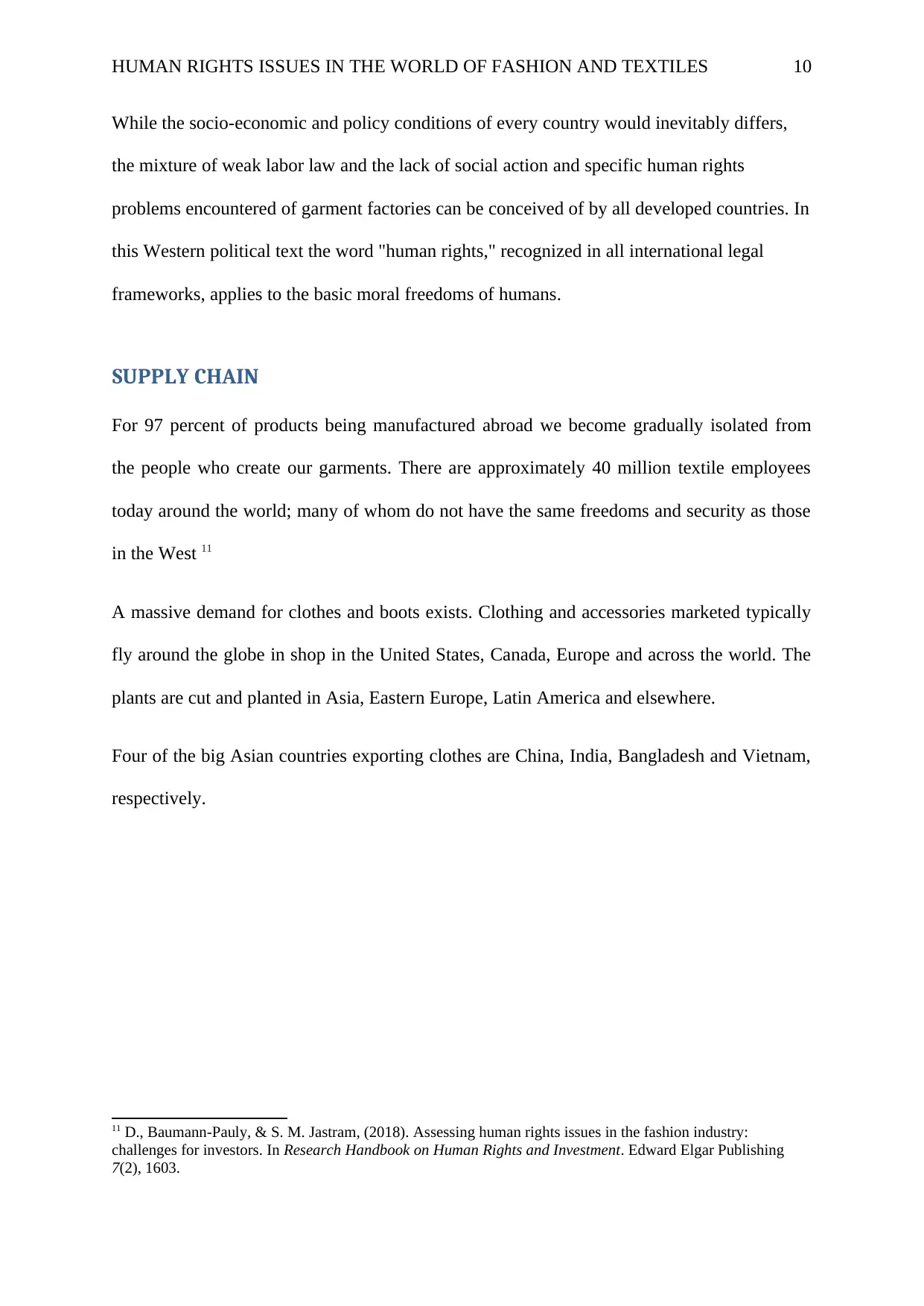
HUMAN RIGHTS ISSUES IN THE WORLD OF FASHION AND TEXTILES 10
While the socio-economic and policy conditions of every country would inevitably differs,
the mixture of weak labor law and the lack of social action and specific human rights
problems encountered of garment factories can be conceived of by all developed countries. In
this Western political text the word "human rights," recognized in all international legal
frameworks, applies to the basic moral freedoms of humans.
SUPPLY CHAIN
For 97 percent of products being manufactured abroad we become gradually isolated from
the people who create our garments. There are approximately 40 million textile employees
today around the world; many of whom do not have the same freedoms and security as those
in the West 11
A massive demand for clothes and boots exists. Clothing and accessories marketed typically
fly around the globe in shop in the United States, Canada, Europe and across the world. The
plants are cut and planted in Asia, Eastern Europe, Latin America and elsewhere.
Four of the big Asian countries exporting clothes are China, India, Bangladesh and Vietnam,
respectively.
11 D., Baumann-Pauly, & S. M. Jastram, (2018). Assessing human rights issues in the fashion industry:
challenges for investors. In Research Handbook on Human Rights and Investment. Edward Elgar Publishing
7(2), 1603.
While the socio-economic and policy conditions of every country would inevitably differs,
the mixture of weak labor law and the lack of social action and specific human rights
problems encountered of garment factories can be conceived of by all developed countries. In
this Western political text the word "human rights," recognized in all international legal
frameworks, applies to the basic moral freedoms of humans.
SUPPLY CHAIN
For 97 percent of products being manufactured abroad we become gradually isolated from
the people who create our garments. There are approximately 40 million textile employees
today around the world; many of whom do not have the same freedoms and security as those
in the West 11
A massive demand for clothes and boots exists. Clothing and accessories marketed typically
fly around the globe in shop in the United States, Canada, Europe and across the world. The
plants are cut and planted in Asia, Eastern Europe, Latin America and elsewhere.
Four of the big Asian countries exporting clothes are China, India, Bangladesh and Vietnam,
respectively.
11 D., Baumann-Pauly, & S. M. Jastram, (2018). Assessing human rights issues in the fashion industry:
challenges for investors. In Research Handbook on Human Rights and Investment. Edward Elgar Publishing
7(2), 1603.
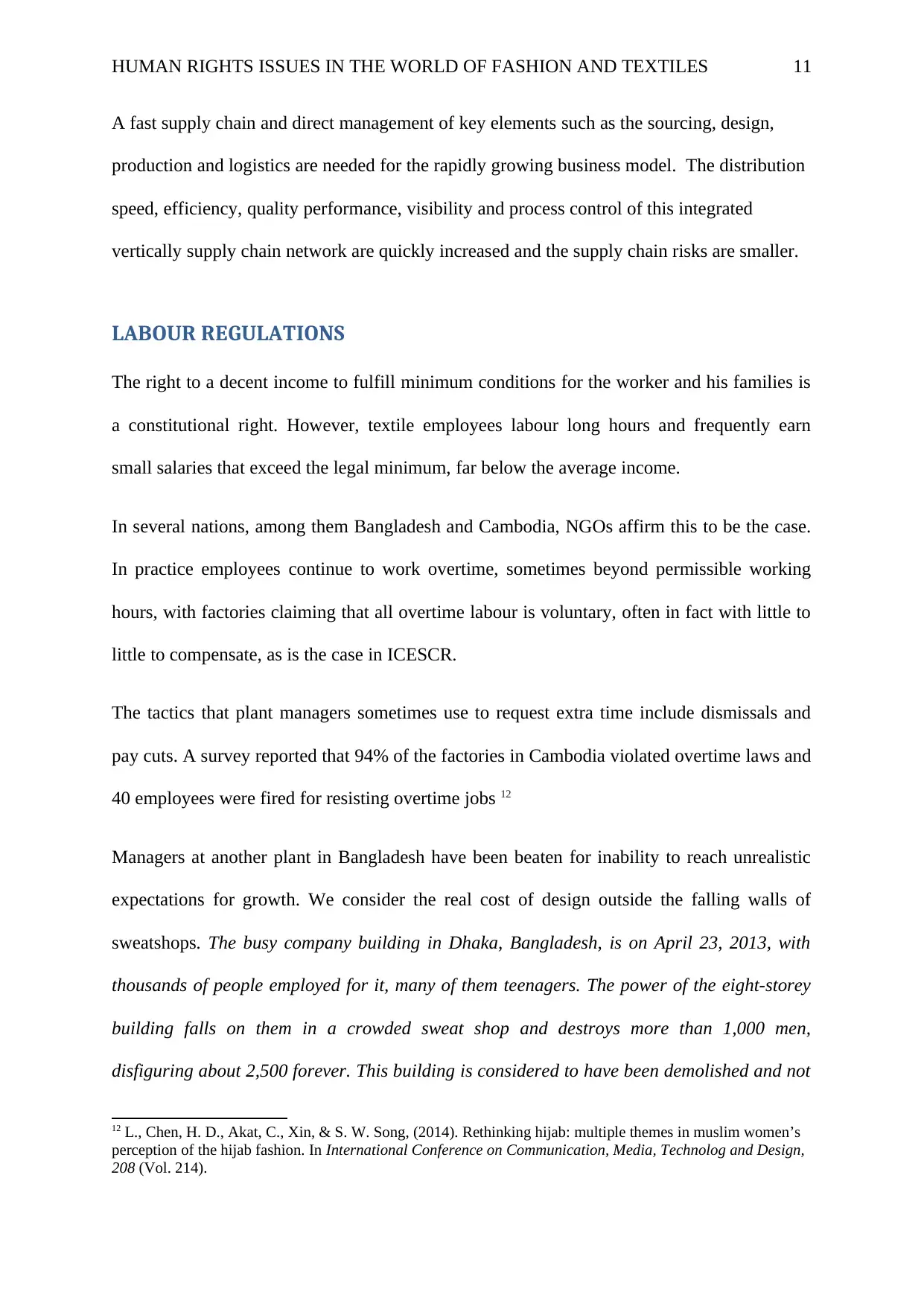
HUMAN RIGHTS ISSUES IN THE WORLD OF FASHION AND TEXTILES 11
A fast supply chain and direct management of key elements such as the sourcing, design,
production and logistics are needed for the rapidly growing business model. The distribution
speed, efficiency, quality performance, visibility and process control of this integrated
vertically supply chain network are quickly increased and the supply chain risks are smaller.
LABOUR REGULATIONS
The right to a decent income to fulfill minimum conditions for the worker and his families is
a constitutional right. However, textile employees labour long hours and frequently earn
small salaries that exceed the legal minimum, far below the average income.
In several nations, among them Bangladesh and Cambodia, NGOs affirm this to be the case.
In practice employees continue to work overtime, sometimes beyond permissible working
hours, with factories claiming that all overtime labour is voluntary, often in fact with little to
little to compensate, as is the case in ICESCR.
The tactics that plant managers sometimes use to request extra time include dismissals and
pay cuts. A survey reported that 94% of the factories in Cambodia violated overtime laws and
40 employees were fired for resisting overtime jobs 12
Managers at another plant in Bangladesh have been beaten for inability to reach unrealistic
expectations for growth. We consider the real cost of design outside the falling walls of
sweatshops. The busy company building in Dhaka, Bangladesh, is on April 23, 2013, with
thousands of people employed for it, many of them teenagers. The power of the eight-storey
building falls on them in a crowded sweat shop and destroys more than 1,000 men,
disfiguring about 2,500 forever. This building is considered to have been demolished and not
12 L., Chen, H. D., Akat, C., Xin, & S. W. Song, (2014). Rethinking hijab: multiple themes in muslim women’s
perception of the hijab fashion. In International Conference on Communication, Media, Technolog and Design,
208 (Vol. 214).
A fast supply chain and direct management of key elements such as the sourcing, design,
production and logistics are needed for the rapidly growing business model. The distribution
speed, efficiency, quality performance, visibility and process control of this integrated
vertically supply chain network are quickly increased and the supply chain risks are smaller.
LABOUR REGULATIONS
The right to a decent income to fulfill minimum conditions for the worker and his families is
a constitutional right. However, textile employees labour long hours and frequently earn
small salaries that exceed the legal minimum, far below the average income.
In several nations, among them Bangladesh and Cambodia, NGOs affirm this to be the case.
In practice employees continue to work overtime, sometimes beyond permissible working
hours, with factories claiming that all overtime labour is voluntary, often in fact with little to
little to compensate, as is the case in ICESCR.
The tactics that plant managers sometimes use to request extra time include dismissals and
pay cuts. A survey reported that 94% of the factories in Cambodia violated overtime laws and
40 employees were fired for resisting overtime jobs 12
Managers at another plant in Bangladesh have been beaten for inability to reach unrealistic
expectations for growth. We consider the real cost of design outside the falling walls of
sweatshops. The busy company building in Dhaka, Bangladesh, is on April 23, 2013, with
thousands of people employed for it, many of them teenagers. The power of the eight-storey
building falls on them in a crowded sweat shop and destroys more than 1,000 men,
disfiguring about 2,500 forever. This building is considered to have been demolished and not
12 L., Chen, H. D., Akat, C., Xin, & S. W. Song, (2014). Rethinking hijab: multiple themes in muslim women’s
perception of the hijab fashion. In International Conference on Communication, Media, Technolog and Design,
208 (Vol. 214).
⊘ This is a preview!⊘
Do you want full access?
Subscribe today to unlock all pages.

Trusted by 1+ million students worldwide
1 out of 22
Your All-in-One AI-Powered Toolkit for Academic Success.
+13062052269
info@desklib.com
Available 24*7 on WhatsApp / Email
![[object Object]](/_next/static/media/star-bottom.7253800d.svg)
Unlock your academic potential
Copyright © 2020–2025 A2Z Services. All Rights Reserved. Developed and managed by ZUCOL.